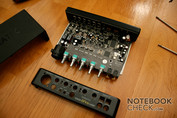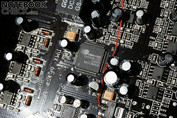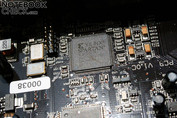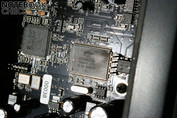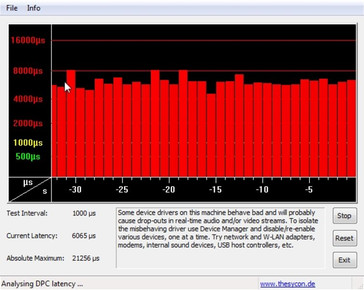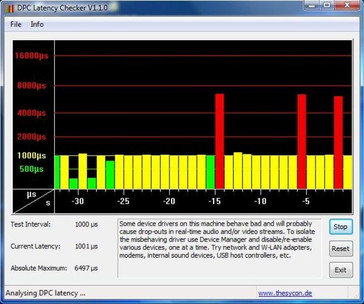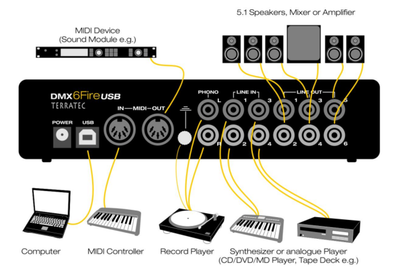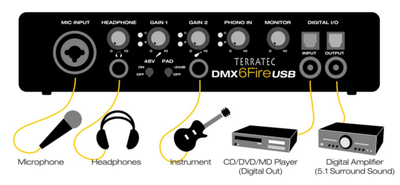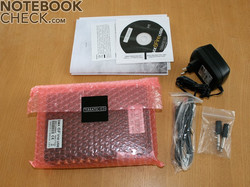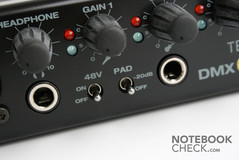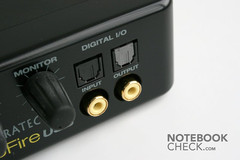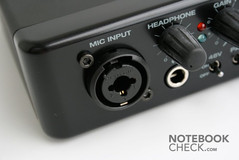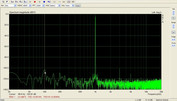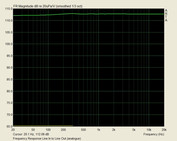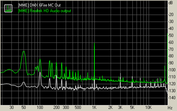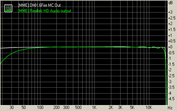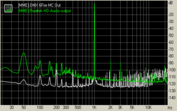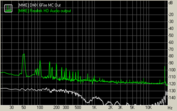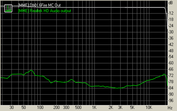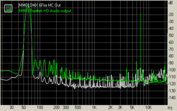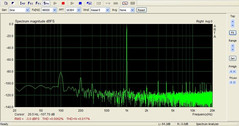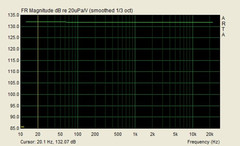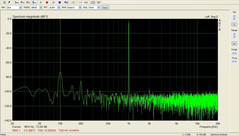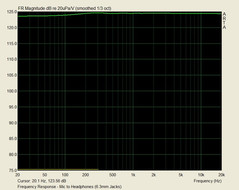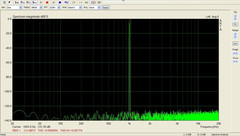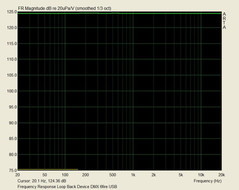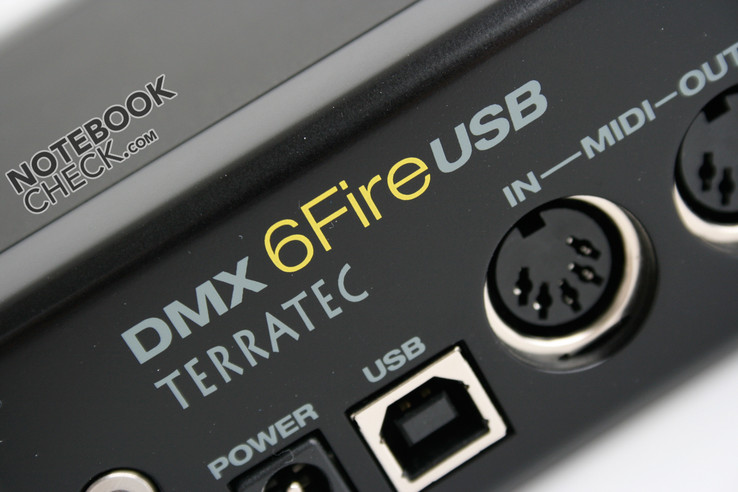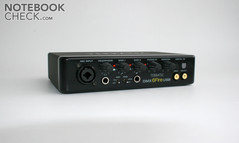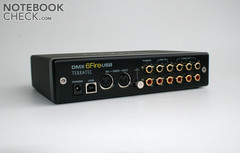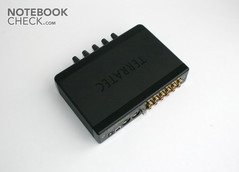Review Terratec DMX 6Fire USB Soundcard
Sound-Pro
Terratec promotes the DMX 6Fire as a professional audio system for USB 2.0. The extensive interfaces, such as phono input with a RIAA-equalizer and Gain control, XLR microphone socket, MIDI ports, 6 analog outputs and 4 inputs, and a digital input and output is made-up to appeal to semi-pros. The DMS 6Fire USB 5.1 surround sound, however, doesn't give gaming fans EAX or OpenAL support. How the card does in the test can be read in the following review
The DMX 6Fire is the official heir soundcard of the PCI plug-in card named DMX 6Fire 24/96. In comparison, the sound solution is now a full external speaker (previously only breakout) and via USB 2.0 port is also notebook-compatible. Furthermore, the new USB solution also now supports 24 Bit/192 KHz.
The external USB 2.0 speaker impresses due to a metal case with a good manufacturing and haptic. The interfaces are allocated on the front and back side and the built-in rubber dial prevents wobbling and has a pleasant haptic.
There are chips from Xilinx (Spartan XC2S100E programmable FPGA with 2700) cells, Cirrus Logic (CS42426-CQZ 6 channel audio IC with PLL 114 dB / 192 KHz) and Cypress (CY7068013A for the USB 2.0 port) found inside of the pocketbook sized USB speaker.
Requirements
Aside from a reasonably modern PC with an USB 2.0 interface, the Terratec DMX 6Fire USB calls for especially good DPC latency values (like every external soundcard). This can be checked beforehand with the freeware DPC Latency Checker Tool (there should only be green bars, possibly a few yellow ones, displayed). Otherwise it may come to disagreeable crackling and disruptive sound output, like it does i.e. in the new MacBook Pro notebooks with Windows. However, there weren't any problems with Mac OS X. The external soundcard even ran smoothly on our older Fujitsu Siemens U9200.
Connectivity
The DMX 6Fire USB soundcard has almost everything that might be desired. The name originating from the six analog cinch outputs (for instance for the connection of a 5.1 system) are only the start. Directly beside them are 4 further analog cinch inputs (2x stereo). A special feature is the dedicated interface for a record player (2x cinch + ground). Furthermore, the back side has ports for digital devices with MIDI ports (input and output) and of course the power socket for the adapter and the USB 2.0 connection.
On the front there are the XLR / 6.3 mm cinch plug for connecting a microphone (48V supplied via a switch). Beside this there is a 6.3mm output for headphones and a 6.3mm input for an instrument (i.e. guitar). There is also the digital input and output via cinch or optical plug on the front.
The volume of the input, the headphone socket and the monitoring function can be adjusted with a dial. Two LEDs per connection provide the optical feedback. The blue LED shows if there is an and how powerful the adjacent signal is (by brightness modulation), the red LED indicates an overdrive.
Also, two adapters for a mini cinch to 6.3 cinch are included. For connecting normal headsets two stereo adapters are needed, though. Therefore you might have to budget a few Euros for a second one.
Software
Terratec supplies drivers for Windows including an own mixer and three applications as software.
Mix Vibe – Pitch, Locator and Cross-Fader conceived for DJs.
Audacity – cutting and recording function
Sound Rescue – against noise and scratching whilst digitization of LPs
There is also a driver package for Mac OS X for downloading, which also has an own, minimally restricted mixer.
Practical Test
Aside from the already described problems with notebooks, which have too high latencies, it rarely came to disturbances of the sound output and input (permanently distorted) during our tests with Max OS X. These could quickly and without problems be fixed by removing and re-inserting the sound card but doesn't really speak for the existing drivers, either.
Functionality
The targeted group quickly becomes obvious with the connectivity at hand. Especially the numerous inputs should be interesting for hobby and semi-professional users. Gamers will rather take soundblaster products from Creative due to the lacking support of EAX or OpenAL. Furthermore, an automatic coding of 5.1 sound to Dolby Digital Live or DTS is missing, as well. The soundcard can, however, transmit an existing signal to the digital outputs (i.e. DVDs).
Worthy of mentioning is also the monitor function, over which a signal can be looped through the speaker and the volume can be modified.
The outputting of 5.1 sound over the rear cinch connections worked perfectly in the test (tested with Window XP and Mac OS X 10.5). The 6 channels can be set in the Windows system control. For Mac OS X, it's necessary to use the Audio-Midi-Setup tool. Additionally, the Wave Play channels were standardly turned off in Mac OS X (can be managed with the Terratec mixer). The 5.1 output worked perfectly with the VLC player afterwards (with a DVD in the test). The DVD player from Mac OS only emitted stereo and we didn't find an option to alter this.
In case the stereo source of the 5.1 system should be used, the Terratec driver also bids the possibility to split the 2-channel signal to all 6 channels. Both front loudspeakers remain unaffected by this. The center sounds a bit fuller and the rear surround channels somewhat muffled. The driver only leads basses with a fixed set crossover frequency. Regrettably, this setting can't be adjusted comfortably and other presettings aren't available either.
Sound Quality
To judge the sound quality is always a difficult task. We used the DMX6Fire USB with an Harman/Kardon AVR 45RDS (6 channel input) with an attached Magnat Vintage 550 5.1 speaker assembly. There was a slight improvement perceptible in comparison to the integrated soundcard of the 2.2 GHz MacBook Pro. Particularly interference noises (from the DVD drive, etc.) didn't turn up at all. In our opinion, the sound quality in the DVD test with analog throughput was also in the quality range of a cheaper receiver.
Colleagues of other media were also satisfied with the external soundcard's sound quality. I.e.:
"The audio quality from the DMX 6Fire is excellent. When compared to audio output through our iMac's headphone jack, it was brighter, punchier and had a wider dynamic range." MacUser.co.uk
Line-connected sources are rendered a bit sober and condensed, according to Stereoplay.
The up-sampled 5.1 sound out of a stereo signal with the Magnat speaker assembly pleased us very good and fitted to most songs, too. Stereoplay considered the up-sampling rather as a makeshift, though.
Measured Data
In order to receive objective measurements we used the software Arta and the RightMark Audio Analyzer with Loop cables to test the soundcard.
We tested the rear analog output and input with a connection via a cheap cinch cable (input ½ to output ½). The input presented itself very good with a signal-to-noise ratio (SNR) of 99 and 95 dB and a distortion factor of 0.004% and 0.0056%. This was measured with a loud sine wave (calibrated to -3 dB by Arta and the integrated routine in the Audio Analyzer).
In comparison to an integrated Realtek HD audio soundcard of the FSC U9200 subnotebook the 6Fire showed considerably better measured data in the measurements.
| RightMark Audio Analyzer Test | DMX 6Fire USB MC Out (Back) | Realtek HD Audio FSC U9200 Subnotebook |
| Frequency response (from 40 Hz to 15 kHz), dB | +0.01, -0.03 | +0.05, -0.31 |
| Noise level, dB (A) | -105.9 | -84.1 |
| Dynamic range, dB (A) | 95.2 | 84.1 |
| THD, % | 0.0056 | 0.011 |
| IMD + Noise, % | 0.015 | 0.052 |
| Stereo crosstalk, dB | -12.0 | -82.2 |
In addition to this, we also measured the connections on the front. The measuring results were somewhat poorer with Arta (the Audio Analyzer couldn't cope with the input of the XLR connection).
| Comparison | Front Connections | Rear Connections |
| Signal-to-Noise Ratio | 70dB | 99dB |
| THD+N | 0,045% | 0,0041% |
| THD | 0,005% | 0,0014% |
Temperature Development
The heat development of the external speaker remained within a limit in the test. The metal case distributes the developing heat well and got perceivably warm while using the soundcard, but not hot.
Verdict
The Terratec DMX 6Fire USB is an external USB 2.0 soundcard and is perfect for upgrading the usually mediocre internal notebook soundcards. It's rather appealing for hobby sound studios due to the comprehensive connectivity. Analog recordings of microphone, record players and guitars are a highlight of the Terratec DMX 6Fire USB. Only few soundcards offer a MIDI and XLR microphone connection. The professional ASIO drivers for Windows also underline the "prosumer" orientation.
Gaming fans will have more of soundblaster cards, as EAX and OpenAL have been omitted in the Terratec solution.
The USB port worked perfectly in the test and made a simple removal and insertion during use possible. It did, however, come twice to sound disruptions with Mac OS X, which could be eliminated by re-inserting.
The measured power consumption ranged from 4.2 to 4.8 Watt. Sadly the device did not power down if the laptop was turned of. So the 6fire still needed 4.2-4.6 Watt.
Attention – The suitability of the base device should be checked before purchase with the DPC Latency Checker.
The card's sound quality could please in the test and both measuring programs showed an evident improvement in comparison to an integrated HD audio soundcard from Realtek.
However, the 6Fire DMX USB's price is set a bit high. But there are barely any other lower-priced alternatives for users who need the interface abundance.
Update: Untill now (2009-11-23) no Snow Leopard drivers are available from Terratec and therefore the soundcard is not usable with Mac OS X 10.6.
| Pro | Con |
|---|---|
| Good sound quality | No power switch |
| Many connections (XLR, MIDI, optical, ...) | High standby power consumption |
| Analog 5.1 output | Merely one stereo cinch adapter included |
| ASIO driver for Windows | No printed manual |
Internet Reviews
Following reviews were found in the internet while writing this report and may contribute to a purchase decision:
- http://www.driverheaven.net/audio-general-technical-discussion/162743-review-new-terratec-dmx-6-fire-usb.html
- http://www.pcfrags.com/pc-hardware-reviews-display_review-82-terratec-dmx-6fire-usb-bb-page-1.html
- http://www.macuser.co.uk/reviews/229011/terratec-dmx-6fire-usb.html
- http://www.stereoplay.de/Testbericht/Terratec-DMX-6Fire-USB_4247840.html





